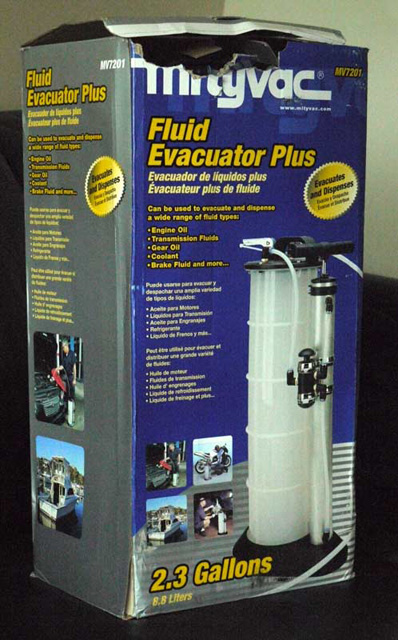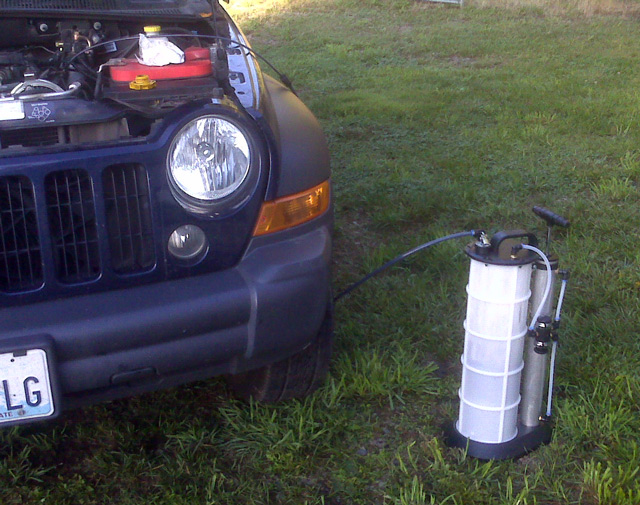I’m not a very good mechanic, but I enjoy working on my cars. Part of it is because I’m cheap, and don’t like spending money on things that can be done myself. The other part of it is that every time I have any interaction with any part of a car dealership, I walk away feeling like a rape victim. Silkwood showers. Haunting regret. The works. Determined to rid myself of that feeling of being used, I made a commitment to gain the skills, and free myself from abuse. There are still a lot of jobs I don’t feel competent to perform on my own, but having the knowledge of how things work prevents me from being at a disadvantage when I buy the services of a professional.
I started by doing oil changes. The procedure itself is so simple that it boggles my mind that anyone pays for the task. Yes, time is money, but a car is a huge portion of the cost of living, and its longevity is abetted by proper maintenance. Knowing that it is done properly adds peace of mind to that longevity. I keep my cars as long as possible and generally wear out their interiors before their drivetrains. Oil changes are the most basic, yet vital maintenance step you can take to keep your car running a long time. Mechanically the process boils down to removing old oil, and pouring in new oil. If you can cook yourself dinner you can change your own oil. The most difficult part of the operation is getting underneath the car to drain the old oil. Now that is no longer an issue!
I first heard about removing the oil out of an engine via the dipstick hole on a mailing list about Diesel Mercedes-Benz cars that I read. Mercedes-Benz dealers only do through-the-dispstick-hole oil changes. I always thought it seemed silly, but now I’m a convert. I recently bought a Mityvac 7201 Fluid Evacuator Plus from Amazon. The event that lead up to my purchase was an accidental over-tightening of the drain bolt in my wife’s Jeep Liberty CRD. Last time I changed her oil I wasn’t paying attention and over-did it when putting the bolt back in. I didn’t strip it completely, but I felt that little “give” that told me I’d be doing a heli-coil job on her pan at some point in my future. (Remember I said at the beginning that I wasn’t a very good mechanic!) I did the bodger’s trick of sealing the bolt in silicone to hold it over until I can fix it properly. Meanwhile I’m still going to have to change the oil. Hence the The Mityvac 7201 Fluid Evacuator Plus.

The unit arrived with a damaged box, which is never a good start to a relationship. Thankfully no parts were missing and nothing was damaged. Included in the box was the unit itself, two different diameter extraction tubes, a main tube, and an instruction manual. I’m one of those guys who reads the manual of every thing I buy, so I sat down to read the skimpy pamphlet that serves as the unit’s instruction manual. It took all of about 32 seconds to complete. I can paraphrase it for you right here:
- Warm up, then shut down your engine. (Warm is good, HOT not so much.)
- Remove your engine’s oil cap and dipstick.
- Insert the main tube into the top of the Mityvac 7201 unit.
- Select an extraction tube that is just slightly smaller than your dipstick hole, and attach that to the main tube.
- Insert extraction tube into the dipstick hole until you hit the bottom of the oil pan (your dipstick will serve as a guide as to how far to expect to slide it down.)
- Make sure the drain plug on the Mityvac 7201 unit is secure.
- Select “Evacuate” from the “Evacuate/Discharge” button options.
- Pump the handle about 10 times, like you would a bicycle pump.
- Stand back and behold the wonder that is the Mityvac 7201 Fluid Evacuator Plus as it sucks the old oil out of your engine!
Here is a photo of it in action this morning on the wife’s CRD:

It takes about two minutes to suck the oil from a 6.7 quart capacity engine like this VM Motori 2.8L CRD. My 4.4 quart TDI took less than that. When it hits bottom and all the oil is out you’ll hear it sucking air. Once finished you pull the extraction tube out and off, insert the main tube into a good portable oil reservoir, flip the switch to “Discharge”, and it’ll blow out the old oil into something handy to carry it in off to the recycling station. Fill your engine with the proper amount of new oil, replace your cap and dipstick, and you are done. You won’t even get your hands dirty! Much faster than draining too.
Unless you have to also change a filter you won’t have to get under the car at all. In the case of my TDI, the filter is on top of the engine, so with that car the entire operation can be done from above. No muss, no fuss. No ramps, no jacks. There are other units besides the Mityvac 7201, but I chose this one for its size and discharge capacity. Some of the cars I care for are vintage machines with 11+ quart oil capacities. (The discharge feature also makes it useful for brake bleeding but I haven’t tested that yet.) The Mityvac 7201 is expensive at around $75, but a budget-minded gearhead could find a usable substitute for as little as $45. If you want powered options (electrical or compressed air) plan on spending a few hundred bucks.
Hmmm. $45-75? This sounds like an ideal solution for oil changes in my Jensen-Healey. The car sits so low that I need to drive it onto a couple of 1x4s to get it high enough that the floor jack will fit underneath.
Thanks for sharing your experiences, Chuck.
You’re welcome Sandro. Since you’re local feel free to drive the J-H or LR up here and try mine out if you like. Always fun to do gearhead stuff with other gearheads.
What? And give up the sensation of warm oil flowing down my arm as I pull out the oil pan plug? 🙂
Back in my marine days a 12V electric dipstick pump was (and still is as far as I know) the standard for oil changes. In many inboard boats there is no reasonable way to get to the drain plug, even if you wanted to crawl into the bilge. Though nothing compares to laying in a greasy wet bilge, except for dropping your wrench further into the greasy wet bilge.
They do work. Its a very civilized process. Unpack, bend hose straight, slip hose into tube, pump it and walk away. Come back, a few more strokes, then walk over to the oil bin and flip the hydro switch and pump and walk away.
Wipe it down, back in box, up to rafters for another 3 months.
Mine leaks a bit, I mean the air pressure drops faster than the oil sucks in. The clamps are not adjustable. Otherwise flawless.
Miatas are mildly known for eating the hose. I mean, you pull it out and it does not come then you pull harder and it breaks off inside. then spend 10 hours removing oil pan to get the broken hose out. Miata.net person seems to have run the car when the hose was in there. Others said it happened to them not running. My Miata likes that thing.
Have this model, and the only caveat I have is be wary of manufacturing defects. You need a good seal at multiple points, and it seems like they have issues with the vendor they farm this out to. I encountered a bad valve.
Lincoln (the progenitor of the device) is relatively local to me, so they sent me a new valve and I got it the next day. Otherwise they’d send you back to the distributor. Their technical support guy is reasonable though.
Another note: Amazon isn’t a valid distributor. That might complicate things, or at least delay returns/exchanges. Seems like there is a good chance of manufacturing defect judging from the Amazon page linked, so if there’s a local distributor my advice would be to go there.
Otherwise, works as reported. Good review.
Thanks for the info Martin. If it breaks I may be contacting you!